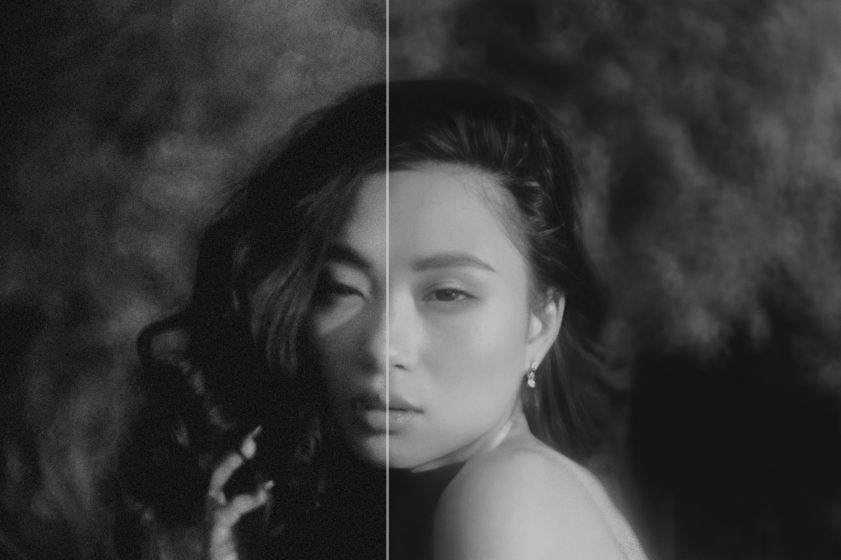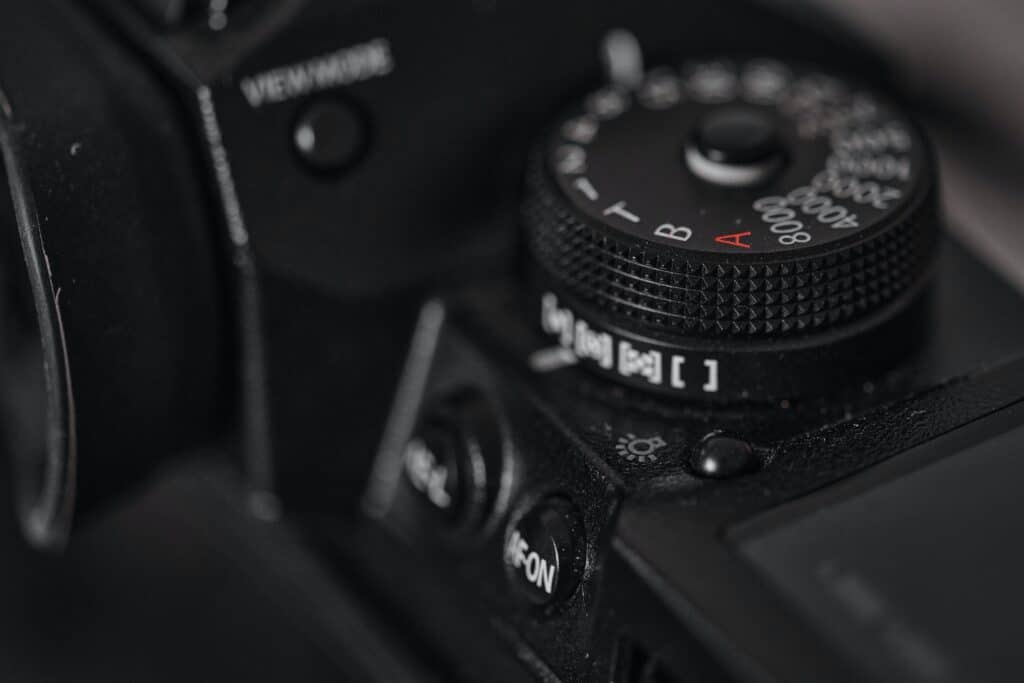12 methods to repair blurry images beyond Photoshop.
October 20th, 2023
Blurriness can ruin a photograph, and it’s frustrating when an otherwise amazing image turns out to be less sharp than you expected. Many photographers don’t know how to fix blurry pictures, and guidance on troubleshooting and repairing blurry images typically focuses on using Photoshop.
If you’re looking for creative ways to fix blurry pictures other than using Photoshop, you’re in the right place.
You’ll learn the whole image repair process from understanding the root causes of blurry photos, fixing blurry images with built-in camera features, and adopting advanced methods from alternative software solutions. We’ll also cover how to avoid unintentionally blurry images altogether by practicing camera techniques that result in sharper photographs.
You’ll learn trade secrets behind repairing blurry images that the pros deem just as effective as Photoshop, if not better.
Understanding the causes of blurry images.
Every photographer has had to deal with unintentionally blurry pictures. The important thing is that you understand why your pictures are blurry so that you can fix them by tackling the source.
Here are the five commonly encountered things that cause blurry images.
Camera shake
Camera shake is the number one thing that causes blurry images. Camera shake is caused by the camera’s movement when the shutter is left open, leading to that familiar blurry look.
Camera shake is often caused by a poorly mounted camera, using too a slow shutter speed relative to the camera’s focal length and available light, or the photographer’s own unsteady hands. The good news is that camera shake can be easily avoided and fixed by checking that gear is working properly together and adjusting your exposure settings.
Out-of-focus subjects
No camera gets focused perfectly a hundred percent of the time, and sometimes even high-quality cameras and lenses have trouble focusing on the subject you want to shoot.
Out-of-focus subjects could be caused by a number of factors, including incorrect focus settings, damaged lenses, malfunctioning autofocus systems, and sometimes a sudden change in the distance between the camera and the subject.
Slow shutter speed
A handheld camera with a slow shutter speed is a perfect recipe for blurry images. A slow shutter speed will make the camera’s shutter open longer, allow more light exposure, and will often cause handheld camera images to be blurry.
As a rule of thumb, the faster your shutter speed is, the less chance there is for blurry images. More on that later.
Low resolution
Picture resolution refers to how much detail an image has and is measured as pixels per inch (ppi). Low-resolution images (small pixel values) can cause images to look blurry because there are fewer pixels available to make the image look crisp. With access to cloud storage and computers able to hand
Image compression
Image compression is the process of converting an image file that consumes less space than the original one. JPG was originally a very lossy compression format, meaning that much of the information in the original image is thrown out. The more information is discarded, the worse the image quality becomes.
With technological advancements today, JPGs are typically excellent for preserving image quality as the final file output. However, you’ll have best results when shooting images in a RAW file format, because this file type retains an advanced amount of pixel data within each image. You’ll still want to avoid making multiple updates to an image already saved as a JPG; compressing the file repeatedly will often make pictures look blurry.

Fixing blurry images with built-in camera features.
Modern digital cameras often include built-in features that help photographers easily fix blurry images without pulling their hair out. Photographers use built-in camera features to get those crisp, sharp images we all love.
Here we’ve compiled four camera features for you to consider:
Utilizing image stabilization
Image stabilization is a built-in camera feature that helps fix camera shake caused by handheld movement so photographers can get a sharp image. Image stabilization goes by various names depending on the camera brand, for example, Vibration Reduction for Nikon, SteadyShot for Sony, Vibration Correct for Tamron, and Image Stabilization for Canon.
This tool alone is not always enough, depending on the lighting and amount of motion in an image, and may need to be combined with some of the other methods in this list.
On a side note, you should turn the image stabilization off when using the camera on a tripod.
Adjusting the focus
Out-of-focus subjects will look blurry in images, and there are several built-in camera features to bring the focus back in on the subject. Autofocus mode is great for an absolute beginner because the camera will decide what area of the subject to focus on.
Alternatively, using the settings to adjust and select the area that will be in focus on your camera screen and then using autofocus to capture images during a quickly changing moment is a great tool. Some newer cameras also include special settings for eye detection, helping you place the focus on human and animal subjects where it is often most important.
Manual focus mode is the ultimate focus adjustment tool and gives you maximum flexibility, but for some fast-moving genres of photography, it is not always possible to manually adjust focus for every shot. This is where the selecting your focal area manually or choosing options like eye detection can help you maximize the use of auto-focus for the best results, creatively and focally.
Increasing shutter speed
An increased shutter speed is the best fix for blurry images caused by a slow shutter speed or camera shake. As a guide, the minimum shutter speed should be reciprocal to double your lens’ focal length to reduce the chance of getting blurry images.
For example: if you’re using a 30mm lens, the reciprocal shutter speed should be at least 1/60s or faster. With a 50mm lens, use at least 1/100s for the shutter speed to avoid getting blurry images.
When photographing moving subjects without a tripod, as you would for weddings, portraits, and sporting events, you’ll need to increase shutter speeds to stop motion and avoid camera blur when running around to get the shot. We recommend to start at 1/200 of a second or faster, depending on your subject–some sports photography genres yield best results around 1/500s or 1/1000s.
Capturing images in RAW format
Shooting in RAW file format may reduce the chance of getting blurry images, or at least make it easier to repair them. A RAW file format tells the camera to take all the information available in a scene and save it as a large file.
A RAW file is an uncompressed image that allows a higher range of flexibility when editing pixels of an image and enables you to fix exposure to a higher degree.
Advanced methods for repairing blurry images.
With the AI tools available in photography today, it often seems there are no blurry images under the sun that good photo editing software can’t fix. Post-processing software offers advanced methods for repairing blurry images that you can add to your toolbox.
Here are three advanced methods for repairing blurry images:
Restoring focus using post-processing software
As digital technology advances, post-processing software from companies like Topaz, Luminar, OnOne, and Adobe can now fix blurry images by restoring them to focus. Advanced post-processing software can apply tools through AI and sharpen up blurry images, some without leaving a hint of an artifact.
There is no longer a need to despair when you find you’ve accidentally messed up your camera settings or focus; all one needs is to find suitable post-processing software and experiment with the settings to get those out-of-focus images fixed in no time.
Focus stacking and blending
Focus stacking is an advanced digital processing technique that blends several images taken at various focus distances (called brackets) to give the resulting image a look with a better exposure blend and a wider depth of field.
Focus stacking and blending can eliminate the blurriness of an image, bring the subject back to focus, and make pictures look magnificently crisp.
Motion deblurring techniques
Motion blur happens when a subject isn’t holding still and you can see the subject’s movement in the picture. The motion deblurring function in the post-processing software corrects the blur caused by linear motion and makes the image look vividly sharp.
The motion deblurring technique is a software tool that uses computer algorithms to remove motion blur from a single image. Various technical methods are developed to compute a deblurred image using complex mathematical models of blur kernel estimation and unblurred image restoration.
Alternative software solutions for fixing blurry photos.
Adobe Photoshop is no longer the only professional photo editing software available in the market, as newer and more innovative software is popping up to compete in the creative market.
Explore these alternative software solutions and discover if there is one that piques your interest.
GIMP
GIMP, GNU Image Manipulation Program, is a popular open-source image-editing software program. Unlike other options, it’s completely free. The software provides numerous customization options and third-party plugins.
Photographers can use GIMP to retouch, manipulate, transcode between different file formats, work on specialized projects, and even draw.
Lightroom
Adobe Lightroom, supported on Windows, macOS, iOS, and Android, is a powerful image organization and manipulation software developed by Adobe Inc. The software is non-destructive, keeps the original image separate from any in-program edits, and saves images in a new file.
Lightroom is perfect for photographers who just want to fix the contrast and exposure on multiple photos at once or apply quick adjustments to them. The recent AI updates allow for more complex masking and edits to subjects, skies, and even individual features of one or more subjects in a portrait. The library feature allows photographers to sort through and organize pictures efficiently.
Topaz Photo AI
Topaz Photo AI by Topaz Labs is a popular editing software that can sharpen, denoise, and increase resolution on images. It can also be used in combination with other editing tools like Photoshop as part of your workflow.
Their sharpening module works differently than traditional sharpening tools, targeting the root cause of the blurriness to correct it with more natural results. In 2023 they released Face Recovery AI that is especially for correcting blurry and old portraits with accuracy and detail.
This software is ideal for any photographer looking to save an important image, refresh an older digital image to higher resolution, or those who frequently work in low light situations or image restoration.
PaintShop Pro
PaintShop Pro by Corel is a raster and vector graphics editor for Microsoft Windows users. It’s a complete photo-editing studio that utilizes artificial intelligence and machine learning technology to enhance images with on-click to make every photo look stunning.
PaintShop Pro is ideal for aspiring photographers who want to leverage smart image editing solutions to help them organize, save, and share their work.
Affinity Photo
Affinity Photo is an award-winning photo editing software and the only fully-loaded photo editor integrated across macOS, Windows, and iPad. Functionalities of Affinity Photo include RAW processing, color space options, live preview of effects, image stitching, alpha compositing, black point compensation, and optical aberration corrections.
Affinity Photo is ideal for photographers who are looking to purchase photo-editing software outright without signing up for monthly subscriptions. It’s the first choice of millions of photography professionals.
Luminar AI
Luminar AI by Skylum is the first photo editing software powered by artificial intelligence, and it’s a universal software application available for Windows and macOS. It can work as a standalone application and as a plugin that integrates with Adobe Photoshop, Adobe Photoshop Elements, Adobe Lightroom Classic, and Photos for macOS.
Photographers love Luminar AI for it helps them discover new possibilities of ideas, remove repetitive routine tasks, and reduce the learning curve to none. Photographers can get breathtaking results whether they have 20 years or 20 seconds of experience.
Importance of proper technique to avoid blurry images.
Proper camera techniques will prevent blurry pictures from occurring in the first place and save you precious time.
You could avoid blurry images by practicing the following:
Using a tripod
A tripod is a popular accessory for photographers as it offers improved stability when cameras are mounted on top and produces sharper images without the frustrating blur.
Tripods also reduce the chances of camera shakes and assist photographers in framing with ease. A tripod lets users capture long exposures in low light; this is particularly helpful for landscape, astral, some types of sports and wildlife photography, and in situations where the photographer does not need to constantly move to capture their subject.
Employing proper autofocus settings.
Choosing the proper autofocus mode is important in shooting tack-sharp images. Camera brands have different names for autofocus settings; however, the most common autofocus mode options are AF-S (single point), AF-C (continuous), and AF-A (automatic).
AF-S locks the focus on the subject only once when you press the shutter button halfway; whereas AF-C will continuously adjust focus as long as you keep the focus point on the subject before snapping that shot.
AF-A puts the camera in the driver’s seat and chooses the autofocus mode it wants based on an assessment of the conditions. It will switch between AF-C and AF-S depending on the subject. If a stationary subject starts moving, it will switch from AF-S to AF-C and vice versa.
Mastering manual focus
Manual focus is the opposite of autofocus and gives photographers the flexibility to select what is in the focus of a frame. Manual focus can compensate for the shortcomings of autofocus, such as low light, low contrast, or backlighting scenarios.
Mirrorless cameras offer the most manual focus options. From the most basic manual focus of using the magnifier, focus peaking, to other options such as distance scale, focus marks, hyperfocal focusing, and many more. Mastering all of the manual focus options will take time, but the reward is great for those who accomplish it.
Practicing capturing images at different shutter speeds.
Shutter speed has a direct correlation to receiving blurry images. As a starting point, matching the shutter speed with the focal length is important in reducing blur in pictures.
The minimum shutter speed to use and avoid the irritating blur is typically 2x the focal length of your lens. So if you are using a 70mm lens, the proper shutter speed would be at least 1/140s.
Ensure that you turn the camera to manual mode first before practicing capturing images at different shutter speeds, and then explore capturing sharp images and playing with intentional blur. Just because unintentional blur can cause frustration, it doesn’t mean that you can’t find creative satisfaction by trying out different types of blur and seeing how they can enhance certain images.
Practice and experiment.
Understanding the causes of blurry images is the first step in figuring out how to fix blurry pictures. Once you understand the root causes behind blurry photographs, it’ll become easier to find ways to both prevent and repair them.
You can fix and repair blurry images either with built-in camera features, or use advanced methods by turning to alternative software solutions. Both are great ways to reduce the occurrence of blurry images; however, getting into a good habit of using proper techniques is the ultimate solution to eliminating unintentionally blurry pictures in the future.
Using a tripod, mastering manual focus, employing proper autofocus settings, and practicing capturing images at different shutter speeds are great habits to start. With these methods in your pocket, take time to experiment and find the solution that works best for you.



